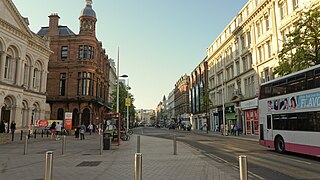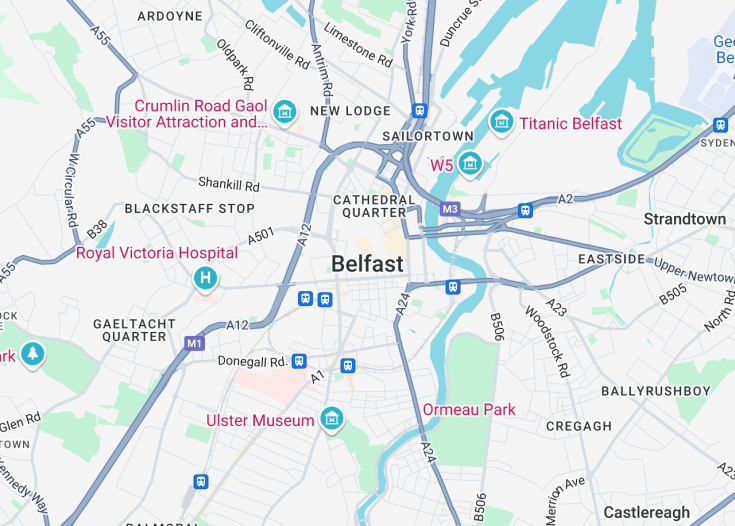Belfast, the capital city of Northern Ireland, is rich in history, culture, and architectural marvels. From the historic shipyards where the Titanic was constructed to the bustling St. George’s Market, the city offers diverse attractions. Visitors can explore museums like the Ulster Museum, enjoy the natural beauty of the Botanic Gardens, and experience the vibrant nightlife. Belfast’s complex history is reflected in its varied neighborhoods, telling stories of industrial prosperity and political struggles, making it a compelling destination for culturally and historically inclined tourists.
For a unique Belfast experience, start your journey at the Titanic Belfast, an immersive museum on the site of the former shipyard where the Titanic was built.
Plan to visit Belfast during late spring or early summer to enjoy mild weather and the lively Belfast Arts Festival, enhancing your cultural exploration.
Top things to do & see in Belfast
Select the following sights and activities to discover best tickets and tours available in Belfast.
Belfast: A City Steeped in History and Culture
| Country | Northern Ireland (United Kingdom) |
| Time in Belfast | GMT |
| Language spoken | English |
| Population | 343,542 (source: latest census) |
| Currency | Pound Sterling (£, GBP) |
| Airports |
|
Belfast, the capital and largest city of Northern Ireland, enchants visitors with its rich history, vibrant culture, and stunning architecture. Rooted in its turbulent past, which includes the well-documented Troubles, Belfast has emerged as a city reborn, vibrant with modernity mingled with tradition. Today, Belfast’s shipbuilding heritage remains a proud hallmark, particularly as the birthplace of the RMS Titanic. The city’s iconic attractions such as the Titanic Belfast museum, Belfast Castle, and the historic City Hall reflect its history and regeneration.
Belfast’s robust cultural scene is marked by annual festivals such as the Belfast International Arts Festival and Belfast Film Festival, showcasing local and international talent. Gastronomy in Belfast is also noteworthy, with a resurgence in traditional Northern Irish cuisine alongside contemporary dining experiences. Furthermore, the city’s recent economic growth has made it a center for innovation and entrepreneurship.
The city’s community-feel intertwined with wide urban spaces not only make Belfast a desirable place to live but also invite travelers looking for a blend of historical depth and contemporary charm. Belfast’s accessibility, further supplemented by extensive redevelopment of its business and entertainment areas, ensures that visitors can enjoy both comfort and adventure.
Increasingly recognized for its educational foundations, the city is home to the prestigious Queen’s University Belfast, fostering a vibrant student population that contributes dynamically to the city’s life. Moreover, Belfast’s commitment to peace and political stability post-Troubles is evident in its active engagement in global peace conferences and initiatives aimed at conflict resolution worldwide.
This modern, bustling cityscape, set against the lush landscapes of Northern Ireland, positions Belfast as a unique travel destination that offers a glance into its diligent past while actively crafting a promising future.
Where is Belfast?
Belfast is located in the eastern part of Northern Ireland, along the banks of the River Lagan on the shores of Belfast Lough.
Distances:
| Route | Distance by car | Time by car |
|---|---|---|
| Londonderry to Belfast | 70 miles | 1 hour 30 minutes |
| Dublin to Belfast | 112 miles | 1 hour 55 minutes |
| Newry to Belfast | 38 miles | 50 minutes |
What is Belfast famous for?
Belfast is known primarily as the birthplace of the RMS Titanic and its rich shipbuilding heritage. Witnessing a cultural and economic revival, it is now celebrated for its post-Troubles developmental success and cultural festivals.
History
Prehistoric Period to Middle Ages
The area now known as Belfast has been settled since the Bronze Age. The Giant’s Ring, a 5,000-year-old henge, marks the early human activity in the region. It wasn’t until the Norman conquest in the 12th century that Belfast began to take shape. John de Courcy built a castle at what is now Castle Place in the city center, establishing a fortified site that would grow over centuries.
17th Century Growth
In the early 1600s, Belfast was a small village under the control of the Chichester family who were instrumental in its development. The town received a major boost when King James I granted it market rights, leading to an influx of English and Scottish settlers. By the end of the century, Belfast was blossoming as a commercial and industrial hub, embracing the burgeoning linen trade.
Industrial Expansion: 19th Century
The 19th century marked Belfast’s transformation into a major industrial powerhouse. The linen industry thrived, and the city became the world’s largest producer. The Harland and Wolff shipyard, founded in 1861, became one of the most famous shipbuilders globally, launching the Titanic in 1912. This period saw a rapid population growth, turning Belfast into Ireland’s biggest city after Dublin and a dominant economic force in the region.
The Troubles: Late 20th Century
The latter half of the 20th century was a tumultuous period for Belfast. The city was at the heart of the Northern Ireland conflict known as “The Troubles,” which involved violent disputes between nationalist and unionist communities. Despite a strong economic downturn during this period, the Good Friday Agreement in 1998 marked a turning point, effectively decreasing the intensity of the conflict and gradually restoring economic and civil stability.
Modern Era
In the 21st century, Belfast has undergone a significant transformation fueled by investment in infrastructure and tourism. The Titanic Quarter, developed in the old shipbuilding areas, is a prominent example, featuring attractions linked to the city’s maritime heritage. Belfast today is recognized for its culture, history, and an increasingly vibrant nightlife and culinary scene, making it a key destination on the island of Ireland.
Visit Belfast
What to see and do in Belfast, Northern Ireland (United Kingdom).
Explore the rich history and vibrant culture of Belfast. Start at the Titanic Belfast, an interactive museum that chronicles the city’s maritime heritage and the ill-fated Titanic, which was built here. Delve into the city’s past at the Ulster Museum and wander through the Botanic Gardens. Don’t miss a visit to the historic Belfast Castle and take a stroll through the Cathedral Quarter, bustling with art, culture, and entertainment.
- Historical tours of the Crumlin Road Gaol
- St. George’s Market for local products and crafts
- Black Taxi tours for a personal history of The Troubles
Annual Festivals and Events in Belfast
Immerse yourself in Belfast’s community life by participating in its annual events. The Belfast Film Festival, held in April, showcases both local and international films. Experience the Belfast Photo Festival in June—an exploration of photographic arts. Celebrate literature at the Belfast Book Festival, also in June, or join the revelry at the Belfast Pride Festival, one of the biggest in Ireland, taking place in July.
Best time to visit Belfast
The best time to visit Belfast is during the late spring to early autumn, from May through September, when the weather is mild and the days are longer, providing ample opportunity to explore the city and engage in outdoor activities.
Is Belfast worth visiting?
Belfast is undoubtedly worth visiting. Beyond its historical significance and the echoes of its complex past, the city offers a dynamic cultural scene, from interactive museums and galleries to live music and theatre. Belfast also serves as a gateway to exploring the natural wonders of Northern Ireland, including the Giant’s Causeway and the beautiful Antrim Coast. Its unique blend of historical and modern attractions, coupled with warm local hospitality, ensures a memorable experience for all visitors.









